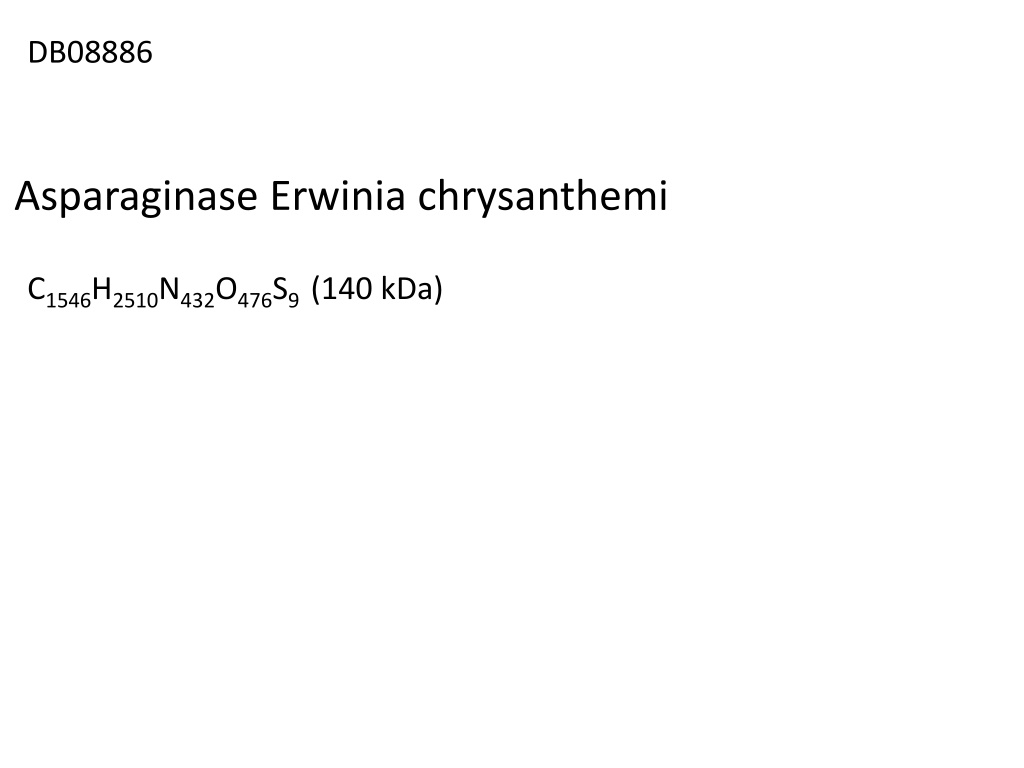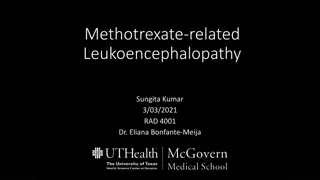Asparaginase Erwinia chrysanthemi
A tetrameric enzyme derived from Erwinia chrysanthemi, used as an antineoplastic agent for patients with acute lymphoblastic leukemia. It reduces circulating asparagine levels, affecting leukemic cell survival. Administered intramuscularly, Erwinaze may cause hypersensitivity reactions and pancreatitis. Dexamethasone interaction requires monitoring. This drug has a lower hypersensitivity incidence compared to E. coli-derived asparaginase, but still carries risks of adverse effects like glucose intolerance, thrombosis, and hemorrhage.
Download Presentation

Please find below an Image/Link to download the presentation.
The content on the website is provided AS IS for your information and personal use only. It may not be sold, licensed, or shared on other websites without obtaining consent from the author.If you encounter any issues during the download, it is possible that the publisher has removed the file from their server.
You are allowed to download the files provided on this website for personal or commercial use, subject to the condition that they are used lawfully. All files are the property of their respective owners.
The content on the website is provided AS IS for your information and personal use only. It may not be sold, licensed, or shared on other websites without obtaining consent from the author.
E N D
Presentation Transcript
DB08886 Asparaginase Erwinia chrysanthemi C1546H2510N432O476S9 (140 kDa)
DESCRIPTION Erwinaze (asparaginase Erwiniachryanthemi) contains an asparaginase specific enzyme derived from Erwiniachrysanthemi. L-asparaginase is a tetrameric enzyme consisting of four identical subunits, each having a molecular weight of about 35 kDa. The activity of Erwinaze is expressed in terms of International Units. It is an antineoplastic agent and was FDA approved in November 19, 2011. INDICATION Asparaginase Erwinia chryanthemi is for the treatment of patients with acute lymphoblastic leukemia (ALL) that have developed a hypersensitivity to Escherichia coli-derivied asparaginase. It is a component of a multi-agent chemotherpeutic regimen for the treatment of the aforementioned disease and is considered second- or third- line treatment in European and American protocols.
MECHANISM OF ACTION Asparaginase Erwinia chrysanthemi catalyzes the deamidation of asparagine to aspartic acid and ammonia, resulting in a reduction in circulating levels of asparagine in the plasma. The mechanism of action of Erwinaze is thought to be based on the inability of leukemic cells to synthesize asparagine due to lack of asparagine synthetase activity, resulting in cytotoxicity specific for leukemic cells that depend on an exogenous source of the amino acid asparagine for their protein metabolism and survival. ABSORPTION denaturation and peptidase digestion within GI tract ROUTE OF ELIMINATION possibly using reticuloendothelial system HALF LIFE Elimination half-life, IM injection = 16 hours, follows first-order kinetics. Compared to E.coli- asparaginase, it has a lower half-life so higher and more frequent doses are necessary. Clearance 3.4 mL/min/m2
TOXICITY Because Erwinaze is injected intramuscularly, there is a higher chance of experiencing major skin reactions. Although the perceived benefit of Erwinia chryanthemi-derivied asparaginase is a lower incidence of hypersensitivity, there is still a chance that one may experience symptoms such as, but not limited to, anaphylaxis, pain, edema. Hypersensitivity to Erwinia chryanthemi-derivied asparaginase may be more likely if the patient had previously had an allergy to E.coli-derived asparaginase. Pancreatitis may also occur during the first few weeks of treatment with asparaginase. In addition, other severe adverse effects associated with Asparaginase Erwinia chrysanthemi are glucose intolerance as well as thrombosis and hemorrhage. DRUG INTERACTIONS Dexamethasone: Monitor therapy as asparaginase Erwinia chrysanthemi may increase the serum concentration of dexamethasone due to a decrease of hepatic proteins necessary for dexamethasone metabolism
ERWINAZE EUSA Pharma Inc. DESCRIPTION tetrameric enzyme consisting of four identical subunits, each having a molecular weight of about 35 kDa = 140 kDa. ERWINAZE (asparaginase Erwinia chrysanthemi) contains an asparagine specific enzyme derived from Erwinia chrysanthemi. L-asparaginase is a tetrameric enzyme consisting of four identical subunits, each having a molecular weight of about 35 kDa. The activity of ERWINAZE is expressed in terms of International Units.
ASSAY: http://www.ncbi.nlm.nih.gov/pcassay/?term=Asparaginase%20Erwinia%20chrysanthemi ADVERSE REACTION: Systemic hypersensitivity, hyperglycemia, abnormal transaminases, fever, pancreatitis, local reactions, vomiting, nausea, thrombosis, hyperbilirubinemia, abdominal pain/discomfort, and diarrhea.
Protein sequence for asparaginase (Erwinia chrysanthemi) monomer ADKLPNIVILATGGTIAGSAATGTQTTGYKAGALGVDTLINAVPEVKKLANVKGEQFSNM ASENMTGDVVLKLSQRVNELLARDDVDGVVITHGTDTVEESAYFLHLTVKSDKPVVFVAA MRPATAISADGPMNLLEAVRVAGDKQSRGRGVMVVLNDRIGSARYITKTNASTLDTFKAN EEGYLGVIIGNRIYYQNRIDKLHTTRSVFDVRGLTSLPKVDILYGYQDDPEYLYDAAIQH GVKGIVYAGMGAGSVSVRGIAGMRKAMEKGVVVIRSTRTGNGIVPPDEELPGLVSDSLNP AHARILLMLALTRTSDPKVIQEYFHTY
REFERENCES Pieters R, Hunger SP, Boos J, Rizzari C, Silverman L, Baruchel A, Goekbuget N, Schrappe M, Pui CH: L-asparaginase treatment in acute lymphoblastic leukemia: a focus on Erwinia asparaginase. Cancer. 2011 Jan 15;117(2):238-49. doi: 10.1002/cncr.25489. Epub 2010 Sep 7 http://www.accessdata.fda.gov/drugsatfda_docs/label/2011/125359lbl.pdf http://www.bccancer.bc.ca/NR/rdonlyres/29039101-BBF2-45CB-A21A- EC4293A76585/64262/Asparaginasemonograph_1June2013_formatted.pdf #http://webprod5.hc-sc.gc.ca/dpd-bdpp/info.do?code=61174&lang=eng PubMed 18421047 http://www.ncbi.nlm.nih.gov/pubmed/25098829 http://www.ncbi.nlm.nih.gov/pubmed/24436152 http://www.ncbi.nlm.nih.gov/pubmed/23794007 http://www.ncbi.nlm.nih.gov/pubmed/22499236



